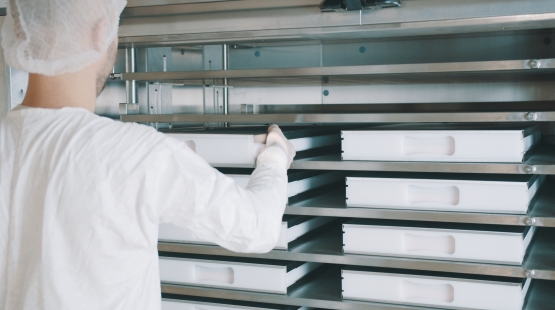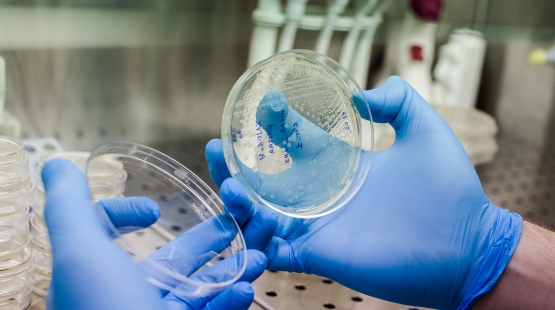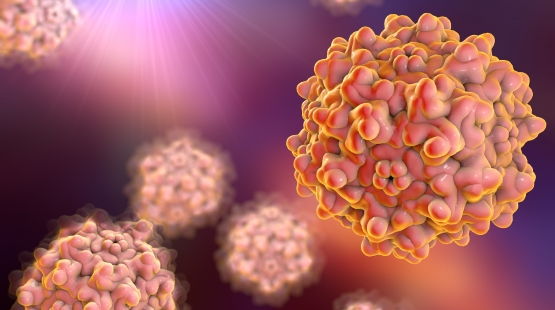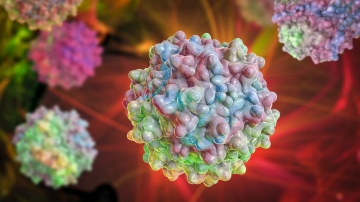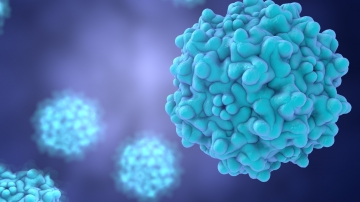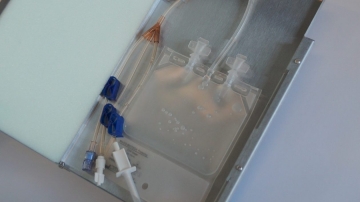AAV production & efficiency improvements with single-use technology
Table of contents
ShowAAV production has become increasingly significant over the past ten years: The Adeno-associated virus vector-based gene therapy is currently the only in-vivo gene therapy approved in the US and Europe.
With adeno-associated virus being a popular viral vector, along with a growing interest in gene therapies, there is an increased need for cost-effective vector manufacturing technologies and viral vector production platforms for human gene therapy products.
Manufacturing platforms need to be able to cover all stages of the gene therapy production process, including development and storage: From cloning design to high titer virus purification, from viral vector production to preclinical and large-scale production, ensuring reliability and adaptability remain key.
This is where Single Use Support can help with its flexible and scalable single-use solutions in fluid & cold chain management. The vendor-agnostic solutions are addressing the demand for more cost-effective and scalable AAV vector production.
Introduction to adeno-associated virus
Adeno-associated virus (AAV) or more specifically recombinant adeno-associated virus (rAAV) stands as a pivotal innovation in the field of gene delivery systems, having undergone significant genetic modifications for its newfound role.
These alterations have rendered rAAVs incapable of self-replication, effectively placing control of this critical aspect of viral infection squarely in the hands of researchers.
Remarkably, these engineered viruses have the ability to maintain their gene expression capabilities. rAAVs have become prominent in recent decades as the preferred choice for investigating in vivo gene function, particularly excelling in gene transfers within the central nervous system.
Their exceptional safety record and extended ability to sustain stable gene expression have established them as the gold standard in preclinical experiments. Additionally, their significant potential for clinical applications holds promise for a variety of medical advancements.1
What is an AAV used for?
The Adeno-associated virus is a crucial vehicle to deliver healthy genes into human cells, making it an important viral vector for gene therapy, a process known as transduction.
The virus’s AAV with their sturdy capsids and inverted terminal repeats play a vital role in accomplishing this goal. When conventional medicines fail to produce results, alternative methods such as various AAV serotypes, AAV particles, modified viruses or other technologies are utilized to support helper-free therapeutic gene transfer, gene delivery, and in-vivo lysis. This approach targets the source of genetic diseases, offering a glimmer of hope for patients afflicted with previously incurable conditions.2
What is AAV made of?
Adeno-associated viruses are composed of a protein shell - the AAV capsid, which surrounds and safeguards a small, single-stranded DNA genome. These viruses rely on co-infection with other viruses in order to replicate. This characteristic not only makes them a gene of interest but also a clear-cut selection for viral genome usage in human gene therapy.
Recombinant AAV (rAAV) represents an AAV particle modified with engineered capsid proteins, designed to traverse the cell membrane and deliver its DNA cargo into the cell nucleus. However, it's important to note that recombinant episomal DNA, unlike integrating into host genomes, remains separate.
Over time, through repeated replication cycles, this episomal DNA gradually dilutes, eventually leading to the loss of the transgene and subsequent transgene expression. This underscores the importance of understanding the dynamics of the AAV vector genome and the role of cap genes, particularly in the context of gene therapy using baculovirus-based expression systems.
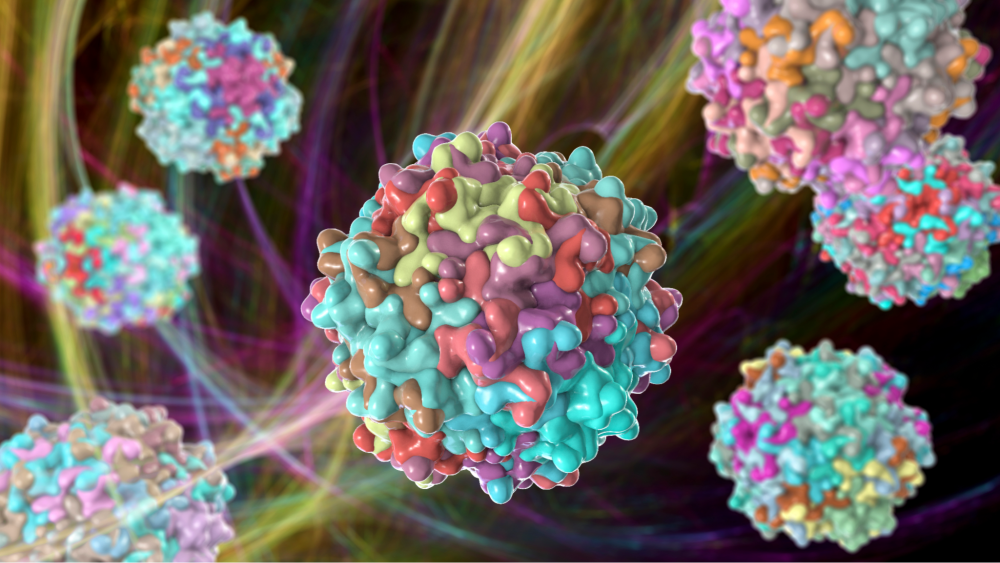
Challenges in AAV production
The production of adeno-associated viruses (AAVs) presents several challenges. Availability remains a significant hurdle, with long waiting times at commercial production facilities, which can delay preclinical research efforts. Furthermore, scalability can be problematic, as upscaling AAV production to meet high-demand requirements often encounters technical and logistical bottlenecks.
This presents a substantial impediment to widespread commercialization and clinical applications. To address these issues, researchers, and technology providers like Single Use Support are actively exploring cost-efficient solutions, such as the development of improved production platforms, the utilization of novel production cell lines, or the optimization of production processes.
These efforts aim to streamline AAV production, enhance availability, and ultimately make AAV-based therapies and research tools more accessible to the scientific community and patients alike. At Single Use Support, we create solutions in the field of gene therapies and personalized medicine. Single-use technology and aseptic filling, freezing, transport and storage solutions for small to large volumes bring efficiency and safety to facilitate commercialization.3
Read more: Challenges in viral vector production3
Keystones of AAV manufacturing
There are different approaches to develop AAV vectors, but irrespective of the chosen manufacturing process, there are following steps in AAV production:
- Plasmid development and production
- Cell expansion
- Plasmid transfection
- Viral vector production
- Purification
- Fill and finish
The preferred method to ensure a long-term and reliable supply of the viral vector, and, in turn, reliable gene therapy products, would be to develop a stable producer cell line in vitro, which, if required, allows for scale-up from preclinical to large-scale production.
Given the potential safety and efficacy risks associated with preexisting immunity to AAV vectors, antibody titers have been included as inclusion or exclusion criteria for gene transfer therapy protocols, while neutralizing assays are used to detect NAbs as well as other non-antibody neutralizing factors.
Development and production of plasmids
The first step of the workflow requires the development and production of large amounts of plasmid DNA, which will subsequently be transfected into the host cells for AAV production. Following bacterial expression, plasmid DNA is harvested and purified from the fermentation culture.
Cell line growth and transfection – when the viral vector production commences
During the transfection process, DNA or RNA is artificially introduced to producer cell lines to enable the study of gene function and protein expression by enhancing or inhibiting specific gene expression. Conventional AAV vector production usually utilizes either insect cells or mammalian cells. When designing transfection experiments, the biological properties of the host cell must be taken into consideration as some promoters may function differently in different cell types while other serotypes are not well suited to particular transfection technologies.
PCR assays can be employed to monitor the presence and expression of the target genes throughout this crucial phase of AAV production, ensuring the desired genetic elements are correctly integrated and expressed within the producer cell lines.
Current adenovirus expression systems avoid using helper viruses but instead include the plasmid pHelper. In the quest for the high amounts necessary for clinical use of recombinant Adeno, companies are moving away from production using adherent HEK293 cells - which are the current choice to supply additionally necessary proteins - to more scalable technologies using suspension cell culture. In addition, the optimization of transient transfection protocols facilitates efficiency in suspension and large-scale production.
Harvest and purification
Apart from the cell type, various factors such as the transfection method or cell line health and viability need to be considered in order for transfection to be successful. Different AAV serotypes have different characteristics, and AAV1 cells for instance are deemed slightly more effective than AAV2 cells. Moreover, AAV vectors have a small cloning capacity, which limits the use of many genetic regulatory elements.
Another factor to be considered is the choice of bioreactor as well as biocontainer. Popular methods used for AAV purification are either based on affinity chromatography or on using a cesium chloride (CsCl) density gradient combined with ultracentrifugation. After two rounds of centrifugation on the virus, the purified virus is extracted as a final step of the AAV vector production process.
Before the viral vectors can be released for clinical use, safety tests are conducted to ensure the plasmid DNA titers are free from any process- or product-related impurities and compliant with any GMP and regulatory requirements.
Aseptic filling with single-use technology
As an integral part of different process steps in viral vector production, it is imperative for the dispensing of vector into single-use bioprocess containers to be sterile. An additional level of safety and reproducibility comes with the integration of automated and closed aliquoting systems, also reducing the risk of contamination while enhancing process efficiency.
Being fully modular, the RoSS.FILL platform allows for maximum flexibility and scalability of both the filling and filtration processes. It is possible to scale from preclinical to large-scale production and allow the filling of unlimited volumes per batch, all at a speed of up to 300L per hour when accelerated speed is the main priority. In case advanced filling accuracy or the filling of up to 100 small bags per batch is required, the process can be customized to ideally meet those requirements. In addition, RoSS.PADL ensures homogeneous distribution of the fluids into the individual single-use bags.
Since the entire filling process is fully disposable, it ensures an absolutely safe handling of the viral vectors or any other given cell culture.
Safe cold chain solutions for AAVs
Once the vector manufacturing process has been completed, the viral vectors need to be transferred from the bioreactor to be stored and/or shipped in a protected manner. This includes freezing (and subsequent thawing) to preserve the AAV vectors for future use.
The fully automated freeze-thaw platforms developed by Single Use Support provide reliable end-to-end solutions for fully controlled freeze/thaw processes of any human gene therapy or other drug substance. The plate-based systems allow for full scalability all the way from clinical trial to commercial bulk production.
In addition, they are compatible with any batch size and bags from all established manufacturers to allow for the greatest flexibility possible.
FAQs about AAV production
How are AAVs manufactured?
AAV vectors are typically manufactured using a plasmid-based approach with a helper virus system. This involves transfecting host cells with the necessary genetic components to produce AAV particles, which are then purified for use in gene therapy or research.
Who produces AAVs?
AAVs are produced by various entities, including academic research laboratories, contract manufacturing organizations (CMOs), and biotechnology companies. Some prominent examples of companies specializing in AAV production are Thermo Fisher Scientific, Vigene Biosciences, Biovian or Lonza. These companies offer customized AAV production services for both research purposes and clinical applications.
How long and at what temperature can AAVs be stored?
AAVs can typically be stored at ultra-low temperatures, around -80°C, for long-term cryopreservation. At this temperature, they remain stable for several years. For short-term storage, AAVs can be kept at -20°C or even up to +4°C for a short period of time. It's essential to avoid multiple freeze-thaw cycles, as they can reduce AAV vector stability and efficacy.
What is a wild-type AAV (adeno-associated virus)?
A wild-type AAV, or adeno-associated virus, refers to the naturally occurring, unaltered form of AAV found in the environment. Wild-type AAVs are viruses that have not been genetically modified or engineered for specific purposes, such as gene therapy. They are typically isolated from various sources, including humans, animals, and the environment, and are characterized by their natural genetic makeup and properties.
Further articles about AAV & viral vector production
- Production of adeno-associated virus vectors for in vitro and in vivo applications, http://dx.doi.org/10.1038/s41598-019-49624-w, Published 2019-09-19
- Adeno-associated virus vector as a platform for gene therapy delivery, http://dx.doi.org/10.1038/s41573-019-0012-9, Published 2019-02-01
- Production of adeno-associated virus vectors for in vitro and in vivo applications, http://dx.doi.org/10.1038/s41598-019-49624-w, Published 2019-09-19



